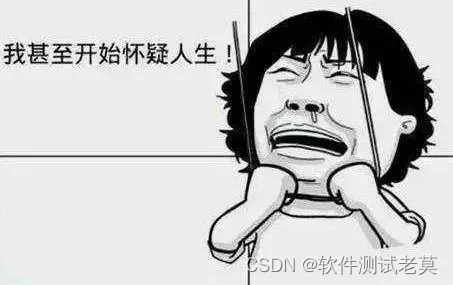当前位置:网站首页>Solve the problem of cache and database double write data consistency
Solve the problem of cache and database double write data consistency
2022-07-05 12:17:00 【Xujunsheng】
Solve the consistency problem of cache and database double write data
The role of caching
At the beginning of the company , When the business volume is relatively small . Read and write requests to the system , Our general practice is to directly operate the database . But with the continuous growth of business volume , Increased user requests , At this time, it is not enough to only use the database to deal with business , There are performance problems . The general practice in the industry is to introduce 「 cache 」.
Caching can improve performance , Relieve database pressure , But at the same time, cache will also appear 「 Cache and database data are inconsistent 」 The problem of .
If the data is inconsistent , It will cause the application to read the latest data in the cache , This is obviously unacceptable . Before we solve this problem , First of all, we need to understand :「 This leads to inconsistent double writes between the cache and the database 」 Why .
The reason why the cache and database double write are inconsistent
Let's take a look first Cache and database consistency definitions :
- Data in cache , And consistent with the database data ;
- No data in cache , The database data is up to date .
that Failure to comply with these two conditions belongs to the problem of inconsistency between cache and database 了 .
When the client sends a data modification request , We don't just have to modify the database , And we'll do it together ( modify / Delete ) cache . There is another order problem in the operation of database and cache : What is the Database first still Operation first cache .
Now let's report to..., as a client MySQL Take the deletion and modification of data in as an example to analyze the inconsistency of data .
Let's not consider concurrency , Under normal circumstances , No matter who comes first, who comes after , Can keep the two consistent , But now we need to focus on abnormal situation .
At this time, the application needs to modify both the database and the cache ( The effects of deletion and modification are similar , Convenience , Only modification operations are described below ) The data of .
Here are two scenarios. Let's take a look at them respectively :
- Modify cache first , Modify the database again
- I'm going to modify the database , Then modify the cache
Let's assume that Modify cache first , Modify the database again . If the cache modification is successful , But the database operation failed , that , When the application accesses the data again , The value in the cache is correct , But once in the cache 「 Data failure 」 perhaps 「 Cache downtime 」, then , The application then accesses the database , At this time, the value in the database is the old value , The application accesses the old value .
If we Update the database first , Update the cache again The value in , Can we solve this problem ? We continue to analyze .
If the application completes the database update first , however , Failed to update cache . that , The value in the database is a new value , In the cache are old values , It must be atypism Of .
This is the time , If there are other concurrent requests to access data , Follow the normal access process , Will first query in the cache , here , You'll read the old value .
Okay , Come here , We can see , In the process of operating the database and updating the cache value , No matter in which order these two operations are executed first, which is later , as long as 「 The operation of the second step 」 failed , This will cause the client to read the old value .
We continue to analyze , except 「 The second operation failed 」 The problem of , What other scenarios will affect data consistency : Concurrency issues .
Consistency problems caused by concurrency
Here are all the strategies , And the deletion and modification operations are discussed separately :
- Update the database first , Update cache after
- Update cache first , Update the database after
- Update the database first , Delete cache after
- So let's delete the cache , Update the database after
Update the database first , Update cache after
Suppose we use 「 Update the database first , Update cache after 」 The plan , And in both steps Successful execution Under the premise of , If there is concurrency , What's going to happen ?
There are threads A And thread B Two threads , You need to update 「 Same article 」 data x, Such a scenario may occur :
- Threads A Update the database (x = 1)
- Threads B Update the database (x = 2)
- Threads B Update cache (x = 2)
- Threads A Update cache (x = 1)
In the end, we found out , In the database x yes 2, And in the cache is 1. Obviously inconsistent .
In addition, this kind of scene is generally Not recommended The use of . Because of some business factors , Finally, the value written to the cache is not consistent with the database , It may take a series of calculations , Finally, write this value to the cache ; If there are a large number of requests to write data to the database at this time , But read requests are not many , At this point, if the cache is updated every time a write request is made , So the performance loss is very large .
For example, in the database x = 1, Now we have 10 A request to add one operation at a time . But during this period, no read operation came in , If you update the database first , Then there will be 10 Requests to update the cache , There's going to be a lot of cold data .
as for 「 Update cache first , Update the database after 」 This situation is consistent with the above problems , We will not continue to discuss .
Whether you modify the cache first or later , In this way, the utilization of cache is not high , It also wastes machine performance . So at this point, we need to consider another scheme : Delete cache .
So let's delete the cache , Update the database after
Let's say I have two threads : Threads A( to update x ), Threads B( Read x ). The following scenarios may occur :
- Threads A Delete the cache first x , Then go to the database for update operation ;
- Threads B Now read x, It is found that the data is not in the cache , Query the database and add it to the cache ;
- And at this point the thread A The transaction for has not yet been committed .
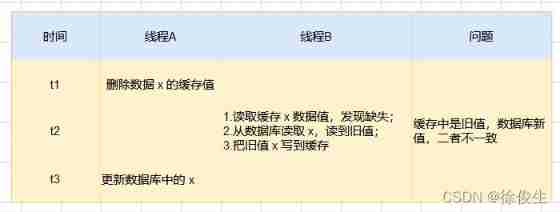
This is the time 「 So let's delete the cache , Update the database after 」 There will still be inconsistencies between the database and the cache .
Update the database first , Delete cache after
We also use two threads : Threads A( to update x ), Threads B( Read x ) give an example .
- Threads A You have to put the data x From 1 Updated to 2, First, the database was successfully updated ;
- Threads B Read required x Value , But threads A The new value has not been updated to the cache ;
- At this point the thread B What I read is old data 1;
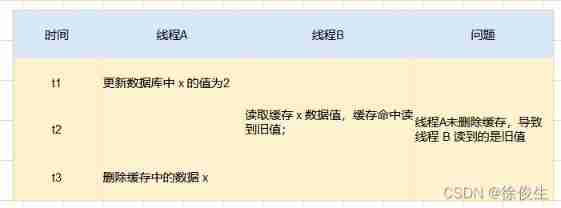
however , The probability of this happening is very small , Threads A Will quickly delete the cache median . thus , When another thread reads again , A cache miss occurs , Then read the latest value from the database . therefore , This situation has little impact on the business .
thus , We can adopt this scheme , To try to avoid the consistency problem between the database and cache in the case of concurrency .
below , We continue to analyze 「 The second operation failed 」, What should we do ?
How to ensure double write consistency
How to ensure 「 The second operation failed 」 The double writing of is consistent ?
Previously, we analyzed that , Whether it's 「 Update cache 」 still 「 Delete cache 」, As long as the second step fails , Then it will cause inconsistency between the database and the cache .
The key here is how to ensure the success of the second step .
First , Introduce a method :「 Message queue based retry mechanism 」.
Message queue based retry mechanism
say concretely , Is to cache operations , Or the request to operate the database is temporarily stored in the queue . Reprocess these requests through the consumption queue .
The process is as follows :
- request A Update the database first ;
- In the face of Redis When deleting, it is found that the deletion failed ;
- At this time will be Yes Redis Delete operation of Send to message queue as message body ;
- The system receives the message sent by the message queue , Again Redis Delete operation .
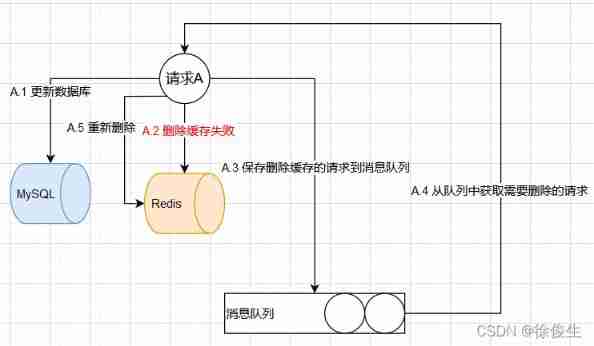 Two features of message queue meet our need for retry :
Two features of message queue meet our need for retry :
- Guarantee reliability : Messages written to the queue , You won't lose until you spend successfully ( Don't worry about restarting the project );
- Ensure that the message is delivered successfully : Downstream pull messages from the queue , The message will not be deleted until it is consumed successfully , Otherwise, it will continue to deliver messages to consumers ( In line with our scenario ).
Problems caused by introducing queues :
- Business code causes a lot of intrusion , At the same time, it increases the maintenance cost ;
- There will also be failures when writing queues .
For those two questions , first , We usually use message queues in projects , Maintenance costs have not increased much . And the probability of failure of both writing queue and cache at the same time is still very small .
If you really don't want to retry using queues in your application , At present, there are also popular solutions : Subscribe to database change logs , Reoperation cache . We are right. MySQL After the database is updated , stay binlog We can find the corresponding operation in the log , So we can subscribe to MySQL Database binlog Logs operate on the cache .
Subscribe to change logs , At present, there are more mature open source middleware , Like Ali's canal.
The general process is as follows :
- The system modifies the database , Generate binlog journal ;
- canal Subscribe to this blog , Get specific operation data , Post to message queue ;
- Through message queuing , Delete data in cache .
summary : Recommend 「 Update the database first , Delete the cache 」 programme , And cooperate with 「 Message queue 」 or 「 Subscribe to change logs 」 To ensure the consistency of database and cache .
How to ensure data consistency in concurrent scenarios
We analyzed earlier , In a concurrent scenario ,「 So let's delete the cache , Update the database 」, Due to network delay , There may be data inconsistency . I'll stick the above picture again .
The core of the problem is : The cache has been planted 「 The old value 」.
Solve this problem , The most effective way is to , Delete the cache . however , You can't delete... Immediately , But needs 「 Delayed deletion 」, This is the solution given by the industry : Cache delay double deletion strategy .

In a thread A After updating the database values , We can let it first sleep For a short time , Do another cache delete operation .
Why add sleep During this period of time , Just to make the thread B Be able to read data from the database first , Then write the missing data to the cache , then , Threads A Then delete .
But here's the problem , This 「 Delay deletion 」 cache , How long will the delay time be set ?
Threads A sleep Time for , You need to be larger than thread B The time to read data and then write it to the cache . This needs to be estimated when the actual business is running .
besides , In fact, there is another scenario that will also have inconsistencies : If the database uses Read write separation architecture , There will also be a time difference between master-slave synchronization , It may also lead to inconsistencies :
- Threads A Update master library x = 2( Original value x = 1);
- Threads A Delete cache ;
- Threads B The query cache , missed , Inquire about 「 Slave Library 」 Get old value ( Slave Library x = 1);
- Slave Library 「 Sync 」 complete ( Master-slave library x = 2);
- Threads B take 「 The old value 」 Write cache (x = 1).
In the final cache x Is the old value 1, The final value of the master-slave library is the new value 2. The data is inconsistent .
The solution to this problem is , For threads B This kind of query operation , You can force it to point to the main database for query , You can also use the above 「 Delay deletion 」 Strategy solution .
Take this approach , It's just to ensure consistency as much as possible , In extreme cases , There is still a possibility of inconsistency .
So in practice , It's still recommended to use 「 Update the database first , Delete the cache 」 The plan , meanwhile , Try to ensure that 「 Master slave copy 」 Don't have too much delay , Reduce the probability of problems .
summary

- The system introduces cache to improve application performance
- After introducing cache , You need to consider the cache and database double write consistency , The options are :「 Update the database + Update cache 」、「 Update the database + Delete cache 」
- Either way , As long as the second step fails , Cannot guarantee the consistency of data , In response to such problems , You can retry the solution through the message queue
- 「 Update the database + Update cache 」 programme , stay 「 Concurrent 」 In this scenario, cache and data consistency cannot be guaranteed , And there are 「 Cache resources are wasted 」 and 「 Machine performance waste 」 What happened , It is generally not recommended to use
- stay 「 Update the database + Delete cache 」 The scheme ,「 So let's delete the cache , Update the database 」 stay 「 Concurrent 」 There are still data inconsistencies in this scenario , The solution is 「 Delay double delete 」, But this delay time is difficult to evaluate , So I recommend 「 Update the database first , Delete the cache 」 The plan
- stay 「 Update the database first , Delete the cache 」 Under the plan , To ensure that both steps are performed successfully , Need to cooperate 「 Message queue 」 or 「 Subscribe to change logs 」 To do , The essence is through 「 retry 」 To ensure data consistency
- stay 「 Update the database first , Delete the cache 」 Under the plan ,「 Read / write separation + Master slave delay 」 It will also lead to inconsistency between cache and database , The solution to this problem is 「 Forced read main database 」 perhaps 「 Delay double delete 」, Send... With experience 「 Delay message 」 Go to the queue , Delay delete cache , At the same time, it is also necessary to control the delay of the master-slave Library , Minimize the probability of inconsistency .
If you want to see more quality original articles , Welcome to my official account. 「ShawnBlog」.
边栏推荐
- POJ-2499 Binary Tree
- One article tells the latest and complete learning materials of flutter
- 1 plug-in to handle advertisements in web pages
- Sentinel sentinel mechanism of master automatic election in redis master-slave
- Reading notes of growth hacker
- How to clear floating?
- Uniapp + unicloud + Unipay realize wechat applet payment function
- Time tools
- Matlab superpixels function (2D super pixel over segmentation of image)
- Acid transaction theory
猜你喜欢
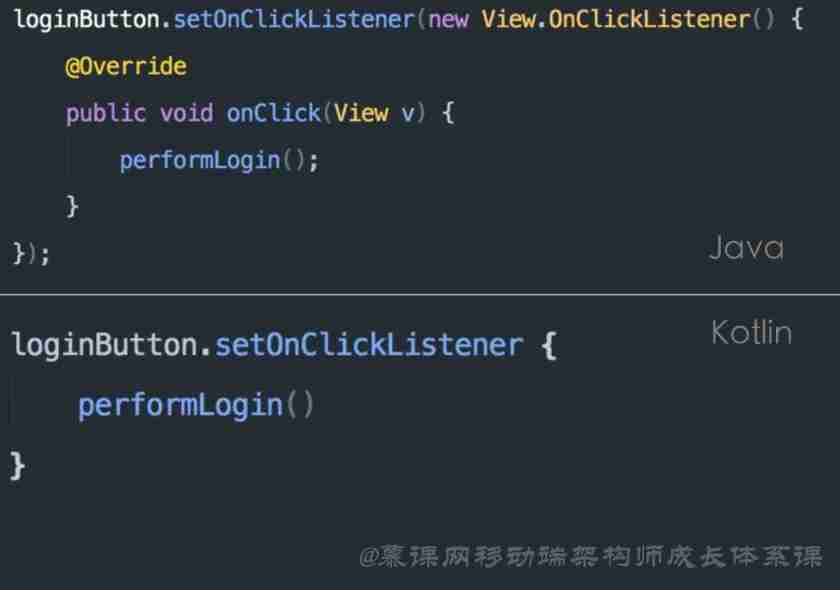
Understand kotlin from the perspective of an architect
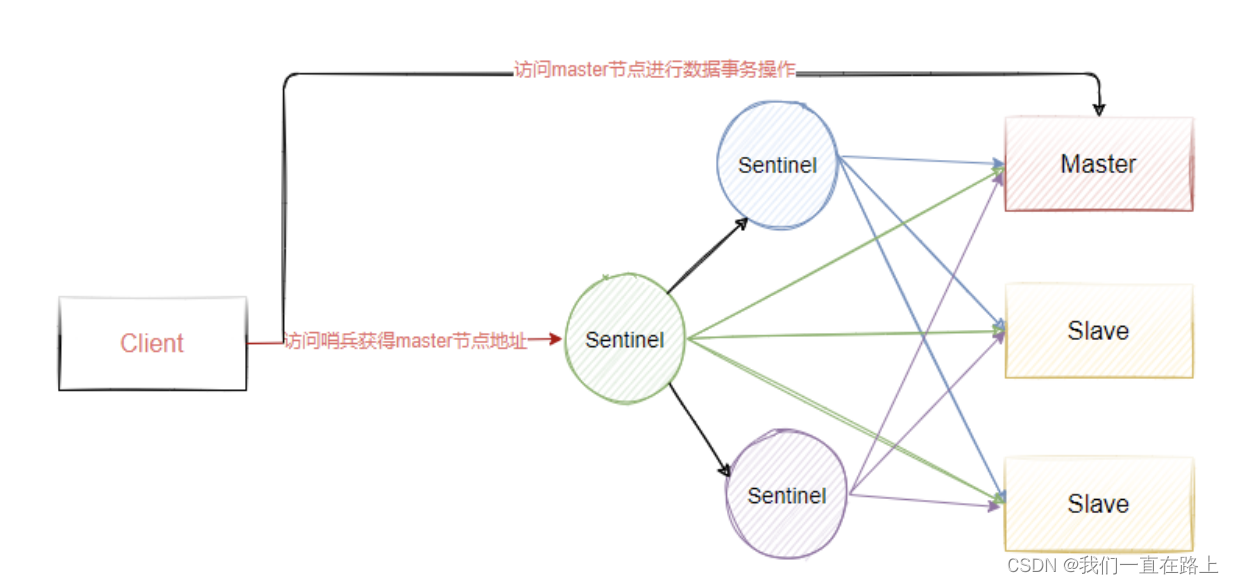
Sentinel sentinel mechanism of master automatic election in redis master-slave
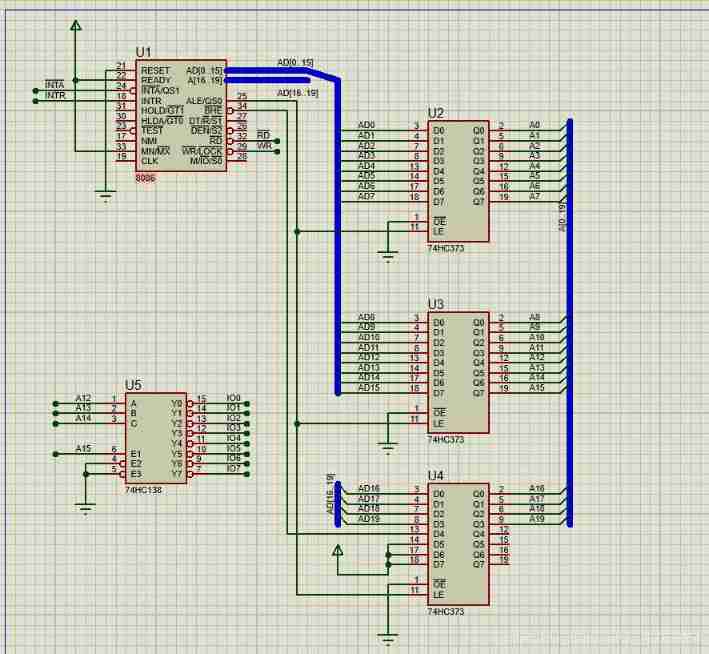
16 channel water lamp experiment based on Proteus (assembly language)

强化学习-学习笔记3 | 策略学习
Automated test lifecycle

Hiengine: comparable to the local cloud native memory database engine

One article tells the latest and complete learning materials of flutter
![[configuration method of win11 multi-user simultaneous login remote desktop]](/img/8f/eab81f089b236c4527a9866b2cfc25.png)
[configuration method of win11 multi-user simultaneous login remote desktop]
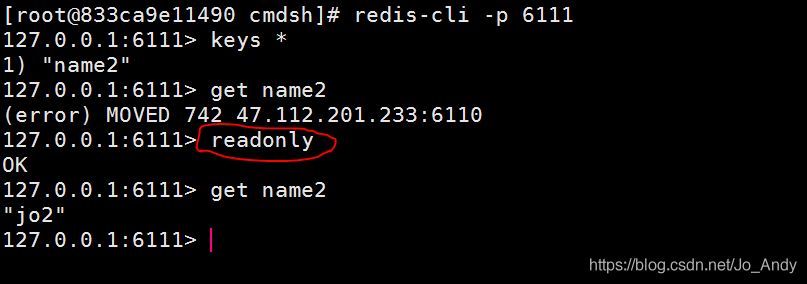
Simply solve the problem that the node in the redis cluster cannot read data (error) moved
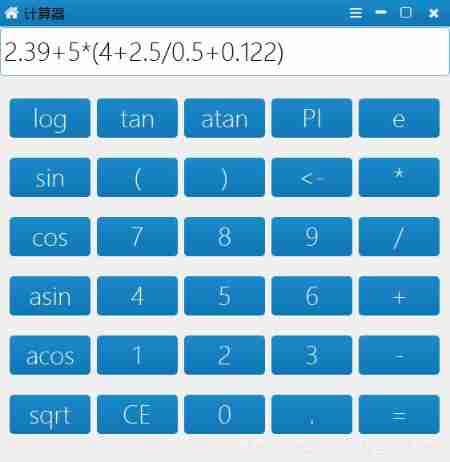
Course design of compilation principle --- formula calculator (a simple calculator with interface developed based on QT)
随机推荐
Error modulenotfounderror: no module named 'cv2 aruco‘
【ijkplayer】when i compile file “compile-ffmpeg.sh“ ,it show error “No such file or directory“.
Design of music box based on assembly language
MySQL regular expression
Troubleshooting of high memory usage of redis in a production environment
POJ-2499 Binary Tree
Principle of redis cluster mode
Flutter2 heavy release supports web and desktop applications
Master the new features of fluent 2.10
Learn memory management of JVM 01 - first memory
codeforces每日5题(均1700)-第五天
Read and understand the rendering mechanism and principle of flutter's three trees
Understand kotlin from the perspective of an architect
Learn garbage collection 01 of JVM -- garbage collection for the first time and life and death judgment
One article tells the latest and complete learning materials of flutter
PXE startup configuration and principle
嵌入式软件架构设计-消息交互
多表操作-子查询
Riddle 1
Splunk configuration 163 mailbox alarm
